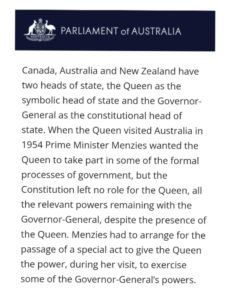Who is the Head of State in Australia?
There is actually a dispute over who the Australian head of state is.
Many consider it to be the Australian born Governor-General. Others say it is the current Monarch of Australia.
The Governor-General is chosen by the Australian government, not by the Monarch.
It may be time to make it clear in the constitution that the Governor-General is the Head of State.
The phrase “head of state” is not currently used in the constitution of Australia.
According to the Parliament of Australia, Australia has two heads of state, the Monarch as the symbolic head of state and the Governor-General as the constitutional head of state.
It was the governor-general who made the famous decision to dismiss the government in 1975, not the Monarch. Queen Elizabeth’s private secretary stated that the power to dismiss the government rested solely with the Governor-General.
Australians for Constitutional Monarchy has argued that the Governor-General is head of state.
Sir David Smith, a former Official Secretary to five governors-general, holds that the governor-general is head of state, while the Monarch is the sovereign of Australia. He based this on the fact that the constitution directs the governor-general, and not the monarch, to carry out the duties of a head of state.
Professor David Flint, convenor of Australians for Constitutional Monarchy, believes that the High Court’s 1907 decision “R v Governor of South Australia” resolves the issue as a constitutional description.
In the 1907 decision of “R v Governor of South Australia’, the court described the Governor-General as the “Constitutional Head of the Commonwealth of Australia”
As a constitutional Monarch, the Monarch, by convention, is not involved in the day-to-day business of the Australian Government, but continues to play ceremonial and symbolic roles only.

